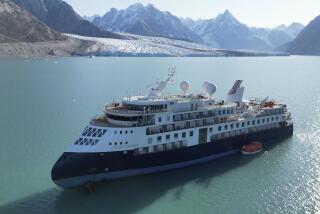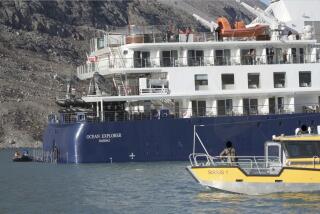Soviets Free Greenpeace Ship in Arctic A-Test Protest : Nuclear issue: The activists are reported sailing for Norway after landing in forbidden territory.
MOSCOW — Soviet authorities on Saturday released a Greenpeace ship seized in icy Soviet seas north of the Arctic Circle during a protest against the Kremlin’s plans to resume testing of nuclear weapons there.
They expelled the ship, the MV Greenpeace, from Soviet waters, and freed without charge four activists who had landed on the forbidden territory of the Novaya Zemlya testing range.
The vessel was detained by KGB agents last Monday for violating Soviet territory, then towed to the northern port of Murmansk and held there for investigation.
It was reported steaming for Norway on Saturday night.
“Our understanding is that, as a result of the inquiry, no charges are going to be filed,” Rebecca Johnson, a Greenpeace spokeswoman, said from the environmental action group’s offices in London.
Johnson said she believes that the activists who landed on Novaya Zemlya--two islands in the Barents Sea used as backup for the main Soviet nuclear testing range in Central Asia--had succeeded in their protest.
“The point that had to be made is that the landing team put itself in danger to avoid a much greater danger--nuclear testing,” she said.
The Greenpeace action was prompted by the prospect that the Soviet Union, blocked from using its main test zone in Central Asia by a powerful local protest movement, would center its testing in the Novaya Zemlya region.
The landing party happened upon the entrance to a shaft into a mountainside that had been used for a test explosion at some time in the past and found that their Geiger counters went off the scale there, Johnson said. They also found high radiation readings at a nearby river bank.
“What this shows is that Soviet claims that they can continue to do underground testing without environmental consequences are clearly false,” she said.
Thirty-eight Greenpeace activists had set out from Murmansk in their 190-foot converted salvage tug with the announced intention of occupying the testing site. Four of them--an American, a German, a Norwegian and an Irishwoman--landed on Novaya Zemlya in rubber dinghies before dawn Monday while others set out in decoy rafts to distract pursuers.
KGB border guards on an icebreaker following the MV Greenpeace demanded that it halt and explain the purpose of the dinghies, firing several warning shots before the vessel finally surrendered, according to KGB and Greenpeace accounts.
Johnson said the landing team spent more than 10 hours on the island, and although authorities confiscated soil samples they took, they still managed to gather data on conditions in the area--one of the main goals of the trip.
The protest was also part of Greenpeace’s “Let’s Disarm the Sea” campaign, which activists say will also take the MV Greenpeace to U.S. and French nuclear testing sites.
MV Greenpeace was involved in a somewhat similar skirmish last December when it was rammed by a U.S. Navy ship as activists tried to disrupt the launch of a Trident 2 submarine missile off Cape Canaveral, Fla.
More to Read
Sign up for Essential California
The most important California stories and recommendations in your inbox every morning.
You may occasionally receive promotional content from the Los Angeles Times.










